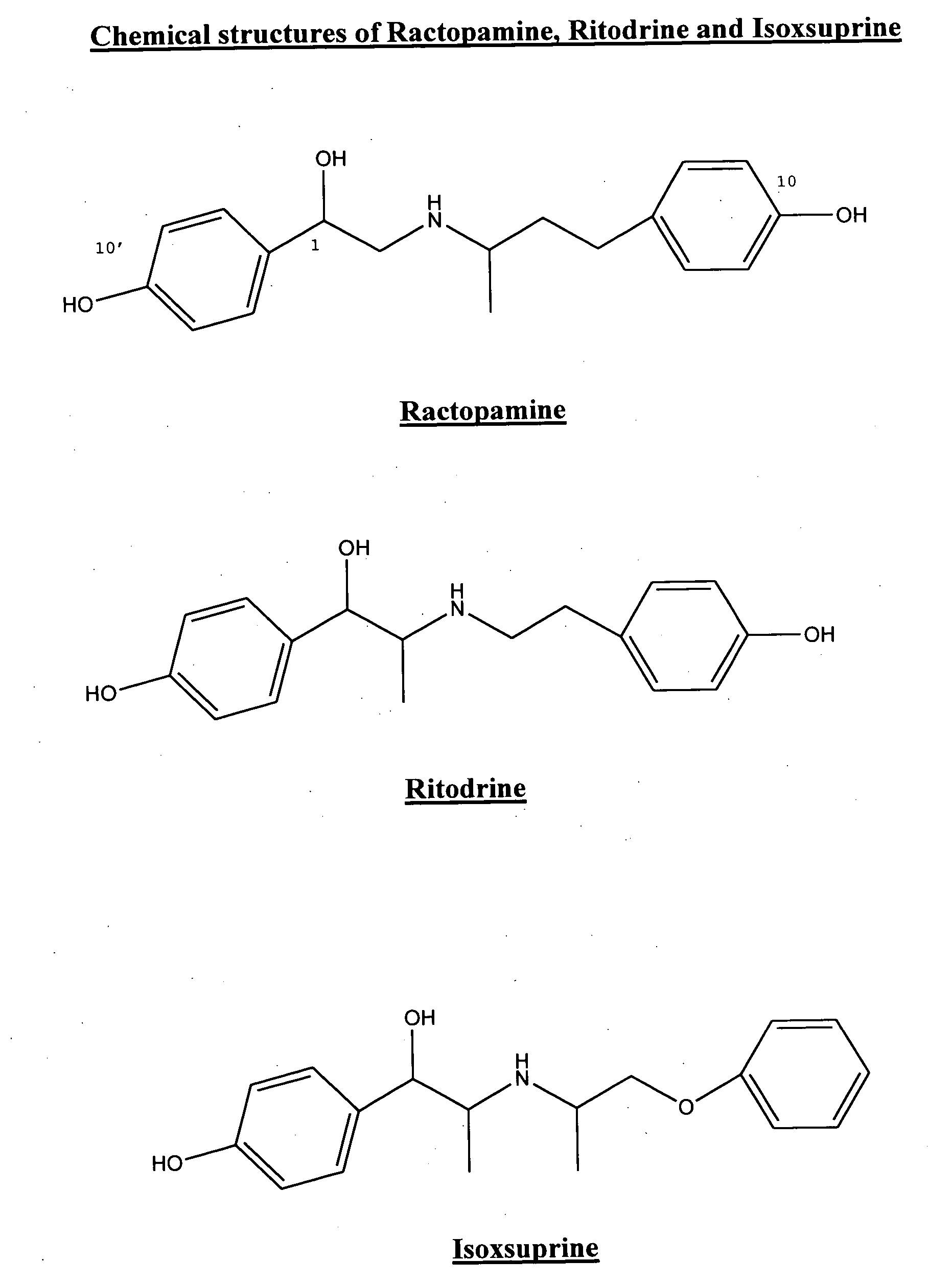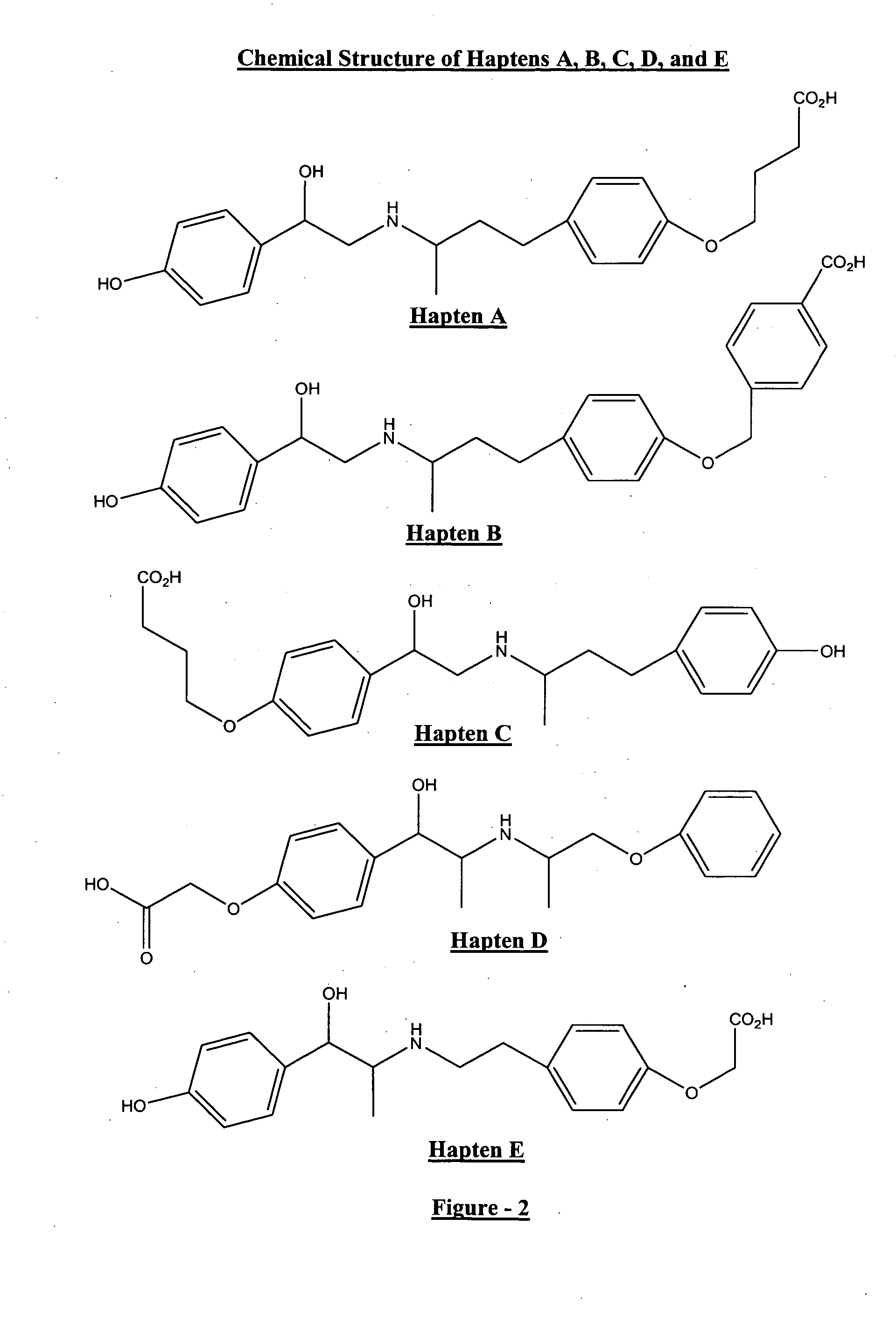Phenethanolamine-derived haptens, immunogens, antibodies and conjugates
a technology of phenethanolamine and hapten, which is applied in the field of phenethanolamine-derived hapten, immunogens, antibodies and conjugates, can solve the problems of ractopamine analysis not being correlated well with gc-ms analysis, human health serious risks, and no prior art discloses or suggests targeted derivatisation of phenethanolamines
- Summary
- Abstract
- Description
- Claims
- Application Information
AI Technical Summary
Benefits of technology
Problems solved by technology
Method used
Image
Examples
example 1
Preparation of Ethyl 4-[4-(3-oxobutyl)phenoxy]butanoate 3
[0072] To a suspension of sodium hydride (60% dispersion in mineral oil) (7.3g, 0.183 mole) in anhydrous DMF (100 ml) under nitrogen atmosphere was added drop-wise 4-(4-hydroxyphenyl)-2-butanone 2 (20.0 g, 0.122 mole) in anhydrous DMF (100 ml) and the mixture was then stirred at room temperature for one hour. To this mixture was added drop-wise ethyl 4-bromobutyrate (28.5g, 0.146 mole) in anhydrous DMF (50ml), and the mixture was then stirred at 60° C. overnight. The DMF was removed under reduced pressure and water (200 ml) was then added to the residue and extracted with ethyl acetate (3×200 ml). The combined organic phases were washed with brine (1×200 ml), dried over magnesium sulfate, filtered and evaporated to dryness. The residue obtained was purified by flash chromatography on silica gel using 20% ethyl acetate in hexane as eluant to give 3 as a colourless oil (16.95 g, 50%) .
[0073] I.R (Film): 1732; 1720; 1612.5; 151...
example 2
Preparation of 10-O-[3-(Ethoxycarbonyl)propyl]ractopamine ether 5
[0074] To a solution of 3 (16.95 g, 0.061 mole) and octopamine.HCl (11.57 g, 0.061 mole) in methanol (300 ml) was added TEA (12.35 g, 0.122 mole) and sodium cyanoborohydride (3.83 g, 0.061 mole). The mixture was stirred at 50° C. overnight. Solvents were removed in vacuo. To the residue were added HCl (1N) (150 ml) and water (150 ml) and washed with ether (1×300 ml). The aqueous phase was adjusted to pH 12-13 using sodium hydroxide (6N) and extracted with ethyl acetate (3×250 ml). The organic layers were combined, dried over magnesium sulfate, filtered and evaporated to dryness. The crude product was purified by flash chromatography on silica gel using 5-10% methanol in chloroform to give the title compound 5 (7 g, 28%) as a white solid.
[0075] I.R (KBr): 3506; 3301.2; 1735.8; 1613.2; 1512.6; 1374.03; 1244.1; 1176.9 and 1046.5.
example 3
Preparation of 10-O-(3-Carboxypropyl)ractopamine ether (Hapten A)
[0076] To a solution of the ester 5 (7 g, 0.169 mole) in methanol (90 ml) was added sodium hydroxide (2N) (30 ml). The mixture was stirred at room temperature for 16 hours. The solvents were removed in vacuo and water ( 50 ml) was added. The pH of the solution was adjusted to 3-4 by addition of HCl (1N) and the resultant precipitate obtained was collected by filtration and dried in a desiccator over P2O5. The hapten A was obtained as a white solid (5.64 g, 86%).
PUM
| Property | Measurement | Unit |
|---|---|---|
| Fraction | aaaaa | aaaaa |
| Fraction | aaaaa | aaaaa |
| Volume | aaaaa | aaaaa |
Abstract
Description
Claims
Application Information
 Login to View More
Login to View More - R&D
- Intellectual Property
- Life Sciences
- Materials
- Tech Scout
- Unparalleled Data Quality
- Higher Quality Content
- 60% Fewer Hallucinations
Browse by: Latest US Patents, China's latest patents, Technical Efficacy Thesaurus, Application Domain, Technology Topic, Popular Technical Reports.
© 2025 PatSnap. All rights reserved.Legal|Privacy policy|Modern Slavery Act Transparency Statement|Sitemap|About US| Contact US: help@patsnap.com



